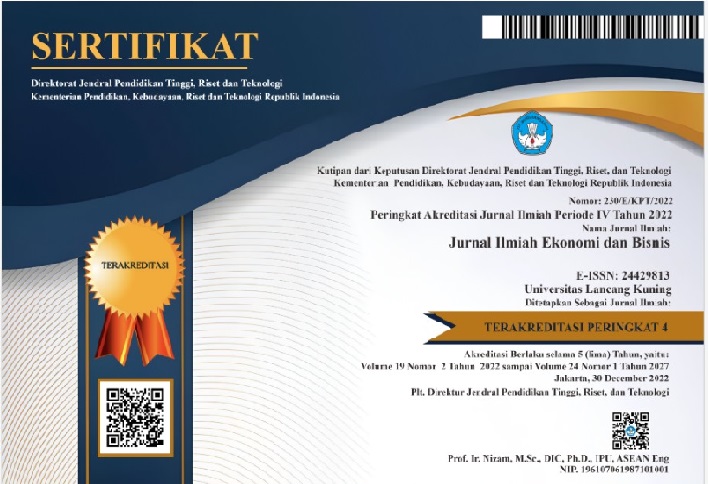PENGARUH KEBIJAKAN RESTRUKTURISASI PEMBIAYAAN, UKURAN BANK, NON PERFORMING FINANCING, DAN PRODUK DOMESTIK BRUTO TERHADAP STABILITAS PERBANKAN SYARIAH DI INDONESIA: BUKTI EMPIRIS DI TENGAH PANDEMI COVID 19
DOI:
https://doi.org/10.31849/jieb.v19i2.7124Keywords:
Islamic Banking Stability, Financing RestructuringAbstract
Abstract: This study aims to analyze the effect of financing restructuring policies through regulation No. 11/ POJK.03/2020 on the stability of Islamic banking in Indonesia. This study uses panel data from the 6 largest Islamic banks in Indonesia for the period September 2018 to December 2020. This study uses the Random Effect Model as the best estimation model. The results showed that the financing restructuring policy had a negative and significant effect on the stability of Islamic banks. Meanwhile, Non-Performing Financing (NPF) and Gross Domestic Product (GDP) as control variables have a significant positive effect on the stability of Islamic banks. Meanwhile, inflation has a negative and significant effect on the stability of Islamic banks. This study did not find the effect of bank size on the stability of Islamic banking in Indonesia.
Keywords: Islamic Banking Stability, Financing Restructuring
References
Ahamed, M. M., & Mallick, S. (2015). Corporate Debt Restructuring, Bank Competition and Stability: Evidence from creditors’ perspective, 44(September), 1–38.
Akram, Q. F., & Eitrheim, Ø. (2008). Flexible inflation targeting and financial stability: Is it enough to stabilize inflation and output? Journal of Banking and Finance, 32(7), 1242–1254. https://doi.org/10.1016/j.jbankfin.2007.10.008
Baltagi, B. (2008). Econometric analysis of panel data. John Wiley & Sons.
Boyd, J. H., Levine, R., & Smith, B. D. (2001). The impact of inlation on financial sector performance. Journal of Monetary Economics, 47, 221–248.
Čihák, M., & Hesse, H. (2010). Islamic Banks and Financial Stability: An Empirical Analysis. Journal of Financial Services Research. Springer. https://doi.org/10.1007/s10693-010-0089-0
Claessens, S. (1999). STRENGTHENING THE BANKING SYSTEM IN CHINA : ISSUES AND EXPERIENCE A joint BIS / PBC conference held Monetary and Economic Department, 7(October).
Denizer, C. A., Dinc, M., & Tarimcilar, M. (2007). Financial liberalization and banking efficiency: Evidence from Turkey. Journal of Productivity Analysis, 27(3), 177–195. https://doi.org/10.1007/s11123-007-0035-9
Deutsche Bundesbank. (2003). Report on the stability of the German financial system. Deutsche Bundesbank Monthly Report, (December 2003), 5–51.
Fasa, M. I., Hendri, L., & Suharto. (2021). " Black Hole " Debt Restructuring and Banking Measures Strengthening Performance and Role of Intermediation : Islamic and Commercial Bank In Indonesian. Integrated Journal of Business and Economics, 75–84.
Fatoni, A., & Sidiq, S. (2019). Analisis perbandingan stabilitas sistem perbankan syariah dan konvensional di indonesia, 11(2). https://doi.org/10.35313/ekspansi.v11i2.1350
Garrido, J. M. (2012). Out-of-court debt restructuring. World Bank.
Gilson, S. C., John, K., & Lang, L. H. P. (1990). Troubled debt restructurings. An empirical study of private reorganization of firms in default. Journal of Financial Economics, 27(2), 315–353. https://doi.org/10.1016/0304-405X(90)90059-9
Gonzales, B., & Hermosillo. (1999). Developing Indicators To Provide Early Warnings of Banking Crises. Finance and Development, 36(2), 36–39. Retrieved from http://www.imf.org/external/pubs/ft/fandd/1999/06/gonzalez.htm
Houben, A., Kakes, J., & Schinasi, G. (2004). Toward a Framework for Safeguarding Financial Stability. IMF Working Papers, 04(101), 1. https://doi.org/10.5089/9781451852547.001
Isik, I., & Hassan, M. K. (2002). Technical, scale and allocative efficiencies of Turkish banking industry. Journal of Banking and Finance, 26(4), 719–766. https://doi.org/10.1016/S0378-4266(01)00167-4
Isshaq, Z., Bokpin, G. A., & Amoah, B. (2012). Efficiency and risk-taking behaviour of Ghanaian Banks. Research in Accounting in Emerging Economies (Vol. 12). Emerald Group Publishing Limited. https://doi.org/10.1108/S1479-3563(2012)000012B007
Laeven, L., Ratnovski, L., & Tong, H. (2014). Bank Size and Systemic Risk: Some International Evidence. International Monetary Fund, Mimeo., 69, 25–27. https://doi.org/10.2139/ssrn.2437729
Osoro, P. M. (2014). Effect of Financial Literacy on Management of Personal Finances Among Employees of Commercial Banks in Kenya, (November), 1–66.
Rahim, S. R. M., & Zakaria, R. H. (2013). Comparison on Stability Between Islamic and Conventional Banks in Malaysia. Journal of Islamic Economics, Banking and Finance, 9(3), 131–149. https://doi.org/10.12816/0001618
Rose, P. S. (1994). THE RESCUE OF TROUBLED BANKS : CONSEQUENCES FOR CORPORATE STRATEGIES TO DEAL WITH FINANCIAL AND OPERATING STRESS. Journal Of Financial And Strategic Decisions, 7(2), 1–17.
Schinasi, G. J. (2006). Preserving Financial Stability. International Monetary Fund. Retrieved from https://www.imf.org/en/Publications/Economic-Issues/Issues/2016/12/30/Preserving-Financial-Stability-17386
Sriyana, J. (2014). Metode Regresi Data Panel. Ekonisia.
Todaro, M. P., & Smith, S. C. (2008). Pembangunan Ekonomi (1st ed.). Jakarta: Erlangga.
Uhde, A., & Heimeshoff, U. (2009). Consolidation in banking and financial stability in Europe: Empirical evidence. Journal of Banking and Finance, 33(7), 1299–1311. https://doi.org/10.1016/j.jbankfin.2009.01.006
Wahyudi, C. A., & Arbay, E. A. (2021). The Impact of OJK Regulation No. 48/POJK.03/2020 the Quality of Credit and Risk Management of Banking Credit. Journal of Economics and Business, 4(1), 204–213. https://doi.org/10.31014/aior.1992.04.01.332
Waxman, M. (1998). A Legal Framework for Systemic Bank Restructuring. SSRN Electronic Journal, (202). https://doi.org/10.2139/ssrn.172984
World Bank (2016). Financial stability. Retrieved from https://www.worldbank.org/ en/publication/ gfdr/gfdr-2016/background/financial-stability
Zhao, T., Casu, B., & Ferrari, A. (2010). The impact of regulatory reforms on cost structure, ownership and competition in Indian banking. Journal of Banking and Finance, 34(1), 246–254. https://doi.org/10.1016/j.jbankfin.2009.07.022












 This work is licensed under a Attribution 4.0 International (CC BY 4.0)
This work is licensed under a Attribution 4.0 International (CC BY 4.0) 